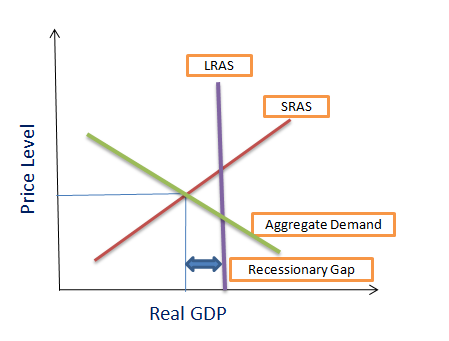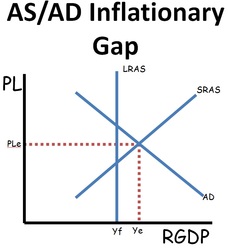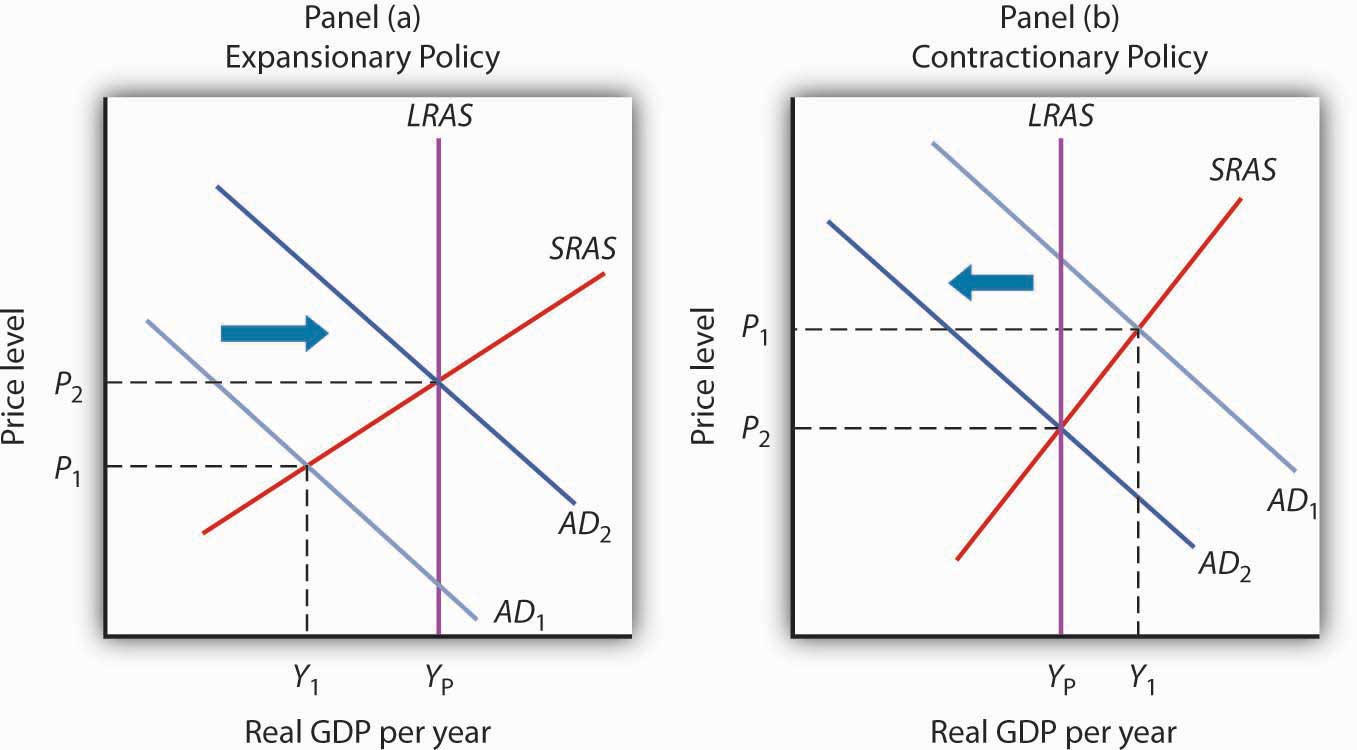
Inflationary and Recessionary Gaps
2 min read•december 17, 2021
Dylan Black
Dylan Black
In AP Macroeconomics, the economy isn't always in perfect long-run equilibrium. When it isn't, there is a gap between the equilibrium GDP in the long run and the short(er)-term equilibrium GDP. There are two types of gaps in AP Macro: recessionary and inflationary gaps.
Recessionary Gaps
In a recessionary gap, there is a lower short-run equilibrium value than the long-run equilibrium value and can be visualized by a leftward shift in aggregate demand.

As you can see, there is a lower value for the short-run equilibrium compared to the long run, implying a recessionary gap. Recessionary gaps are characterized by high unemployment and low prices. This gap can be closed either in the long run by a shift in short-run aggregate supply due to wage changes, or by expansionary fiscal/monetary policy.
Long-Run Adjustment
For a recessionary gap, in the long run, SRAS shifts to correct the gap. The way this happens is: low prices lead to lower nominal wages, which leads to a rightward shift in SRAS, closing the gap.
Inflationary Gaps
In a recessionary gap, there is a higher short-run equilibrium value than the long-run equilibrium value and can be visualized by a rightward shift in aggregate demand.

As you can see, there is a higher value for the short-run equilibrium (Ye) compared to the long run (Yf), implying an inflationary gap. Inflationary gaps are characterized by low unemployment and high prices. This gap can be closed either in the long run by a shift in short-run aggregate supply due to wage changes, or by contractionary fiscal/monetary policy.
Long-Run Adjustment
For an inflationary gap, in the long run, SRAS shifts to correct the gap. The way this happens is: higher prices lead to higher nominal wages, which leads to a leftward shift in SRAS, closing the gap.
Graphs for Policy Changing AD

Congratulations! You now understand inflationary and recessionary gaps and how they can be created and closed. Good luck!
Inflationary and Recessionary Gaps
2 min read•december 17, 2021
Dylan Black
Dylan Black
In AP Macroeconomics, the economy isn't always in perfect long-run equilibrium. When it isn't, there is a gap between the equilibrium GDP in the long run and the short(er)-term equilibrium GDP. There are two types of gaps in AP Macro: recessionary and inflationary gaps.
Recessionary Gaps
In a recessionary gap, there is a lower short-run equilibrium value than the long-run equilibrium value and can be visualized by a leftward shift in aggregate demand.

As you can see, there is a lower value for the short-run equilibrium compared to the long run, implying a recessionary gap. Recessionary gaps are characterized by high unemployment and low prices. This gap can be closed either in the long run by a shift in short-run aggregate supply due to wage changes, or by expansionary fiscal/monetary policy.
Long-Run Adjustment
For a recessionary gap, in the long run, SRAS shifts to correct the gap. The way this happens is: low prices lead to lower nominal wages, which leads to a rightward shift in SRAS, closing the gap.
Inflationary Gaps
In a recessionary gap, there is a higher short-run equilibrium value than the long-run equilibrium value and can be visualized by a rightward shift in aggregate demand.

As you can see, there is a higher value for the short-run equilibrium (Ye) compared to the long run (Yf), implying an inflationary gap. Inflationary gaps are characterized by low unemployment and high prices. This gap can be closed either in the long run by a shift in short-run aggregate supply due to wage changes, or by contractionary fiscal/monetary policy.
Long-Run Adjustment
For an inflationary gap, in the long run, SRAS shifts to correct the gap. The way this happens is: higher prices lead to higher nominal wages, which leads to a leftward shift in SRAS, closing the gap.
Graphs for Policy Changing AD

Congratulations! You now understand inflationary and recessionary gaps and how they can be created and closed. Good luck!

Resources
© 2024 Fiveable Inc. All rights reserved.
AP® and SAT® are trademarks registered by the College Board, which is not affiliated with, and does not endorse this website.